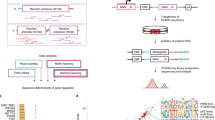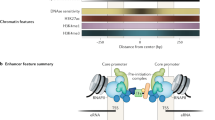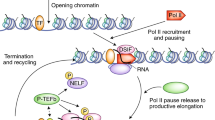Abstract
Revealing the molecular principles of eukaryotic transcription factor assembly on specific DNA sites is pivotal to understanding how genes are differentially expressed. By analyzing structures of transcription factor complexes bound to specific DNA elements we demonstrate how protein and DNA regulators manage gene expression in a combinatorial fashion.
This is a preview of subscription content, access via your institution
Access options
Subscribe to this journal
Receive 12 print issues and online access
$189.00 per year
only $15.75 per issue
Buy this article
- Purchase on Springer Link
- Instant access to full article PDF
Prices may be subject to local taxes which are calculated during checkout



Similar content being viewed by others
References
Glass, C.K. Differential recognition of target genes by nuclear receptor monomers, dimers, and heterodimers. Endocr. Rev. 15, 391–407 (1994).
Shore, P. & Sharrocks, A.D. The MADS-box family of transcription factors. Eur. J. Biochem. 229, 1–13 (1995).
Wegner, M. From head to toes: the multiple facets of Sox proteins. Nucleic Acids Res. 27, 1409–1420 (1999).
Herr, W. & Cleary, M.A. The POU domain: versatility in transcriptional regulation by a flexible two-in-one DNA-binding domain. Genes Dev. 9, 1679–1693 (1995).
Ptashne, M. & Gann, A. Genes & Signals (Cold Spring Harbor Laboratory Press, Cold Spring Harbor, New York, 2002).
Tjian, R. & Maniatis, T. Transcriptional activation: a complex puzzle with few easy pieces. Cell 77, 5–8 (1994).
Lefstin, J.A. & Yamamoto, K.R. Allosteric effects of DNA on transcriptional regulators. Nature 392, 885–888 (1998).
Rastinejad, F., Perlmann, T., Evans, R.M. & Sigler, P.B. Structural determinants of nuclear receptor assembly on DNA direct repeats. Nature 375, 203–211 (1995).
Mangelsdorf, D.J. & Evans, R.M. The RXR heterodimers and orphan receptors. Cell 83, 841–850 (1995).
Pellegrini, L., Tan, S. & Richmond, T.J. Structure of serum response factor core bound to DNA. Nature 376, 490–498 (1995).
Hassler, M. & Richmond, T.J. The B-box dominates SAP-1-SRF interactions in the structure of the ternary complex. EMBO J. 20, 3018–3028 (2001).
Tan, S. & Richmond, T.J. Crystal structure of the yeast MATα2/MCM1/DNA ternary complex. Nature 391, 660–666 (1998).
Ryan, A.K. & Rosenfeld, M.G. POU domain family values: flexibility, partnerships, and developmental codes. Genes Dev. 11, 1207–1225 (1997).
Kamachi, Y., Uchikawa, M. & Kondoh, H. Pairing SOX off: with partners in the regulation of embryonic development. Trends Genet. 16, 182–187 (2000).
Dailey, L. & Basilico, C. Coevolution of HMG domains and homeodomains and the generation of transcriptional regulation by Sox/POU complexes. J. Cell Physiol. 186, 315–328 (2001).
Ambrosetti, D.C., Basilico, C. & Dailey, L. Synergistic activation of the fibroblast growth factor 4 enhancer by Sox2 and Oct-3 depends on protein-protein interactions facilitated by a specific spatial arrangement of factor binding sites. Mol. Cell. Biol. 17, 6321–6329 (1997).
Avilion, A.A. et al. Multipotent cell lineages in early mouse development depend on SOX2 function. Genes Dev. 17, 126–140 (2003).
Remenyi, A. et al. Crystal structure of a POU/HMG/DNA ternary complex suggests differential assembly of Oct4 and Sox2 on two enhancers. Genes Dev. 17, 2048–2059 (2003).
Di Rocco, G. et al. The recruitment of SOX/OCT complexes and the differential activity of HOXA1 and HOXB1 modulate the Hoxb1 auto-regulatory enhancer function. J. Biol. Chem. 276, 20506–20515 (2001).
Williams, D.C. Jr., Cai, M. & Clore, G.M. Molecular basis for synergistic transcriptional activation by Oct1 and Sox2 revealed from the solution structure of the 42-kDa Oct1.Sox2.Hoxb1-DNA ternary transcription factor complex. J. Biol. Chem. 279, 1449–1457 (2004).
Kamachi, Y., Uchikawa, M., Tanouchi, A., Sekido, R. & Kondoh, H. Pax6 and SOX2 form a co-DNA-binding partner complex that regulates initiation of lens development. Genes Dev. 15, 1272–1286 (2001).
Klemm, J.D., Rould, M.A., Aurora, R., Herr, W. & Pabo, C.O. Crystal structure of the Oct-1 POU domain bound to an octamer site: DNA recognition with tethered DNA-binding modules. Cell 77, 21–32 (1994).
Tomilin, A. et al. Synergism with the coactivator OBF-1 (OCA-B, BOB-1) is mediated by a specific POU dimer configuration. Cell 103, 853–864 (2000).
Remenyi, A. et al. Differential dimer activities of the transcription factor Oct-1 by DNA-induced interface swapping. Mol. Cell 8, 569–580 (2001).
Chasman, D., Cepek, K., Sharp, P.A. & Pabo, C.O. Crystal structure of an OCAB peptide bound to an Oct-1 POU domain/octamer DNA complex: specific recognition of a protein-DNA interface. Genes Dev. 13, 2650–2657 (1999).
Magne, S., Caron, S., Charon, M., Rouyez, M.C. & Dusanter-Fourt, I. STAT5 and Oct-1 form a stable complex that modulates cyclin D1 expression. Mol. Cell. Biol. 23, 8934–8945 (2003).
Scully, K.M. et al. Allosteric effects of Pit-1 DNA sites on long-term repression in cell type specification. Science 290, 1127–1131 (2000).
Bulyk, M.L. Computational prediction of transcription-factor binding site locations. Genome Biol. 5, 201 (2003).
Taverner, N.V., Smith, J.C. & Wardle, F.C. Identifying transcriptional targets. Genome Biol. 5, 210 (2004).
Author information
Authors and Affiliations
Corresponding author
Ethics declarations
Competing interests
The authors declare no competing financial interests.
Rights and permissions
About this article
Cite this article
Reményi, A., Schöler, H. & Wilmanns, M. Combinatorial control of gene expression. Nat Struct Mol Biol 11, 812–815 (2004). https://doi.org/10.1038/nsmb820
Received:
Accepted:
Published:
Issue Date:
DOI: https://doi.org/10.1038/nsmb820
This article is cited by
-
Alteration in DNA-binding affinity of Wilms tumor 1 protein due to WT1 genetic variants associated with steroid - resistant nephrotic syndrome in children
Scientific Reports (2022)
-
In silico analysis of key regulatory networks related to microfibril angle in Populus trichocarpa Hook.
Biologia (2022)
-
Biological processes and signal transduction pathways regulated by the protein methyltransferase SETD7 and their significance in cancer
Signal Transduction and Targeted Therapy (2018)
-
Transcriptome and Co-Expression Network Analyses Identify Key Genes Regulating Nitrogen Use Efficiency in Brassica juncea L.
Scientific Reports (2018)
-
Combinatorial control of gene expression in Aspergillus niger grown on sugar beet pectin
Scientific Reports (2017)



